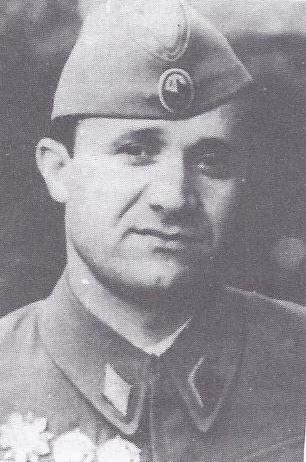Years of service 1941 - 1945 Rank Lieutenant General | Name Petar Drapsin | |
 | ||
Allegiance Second Spanish RepublicYugoslavia Service/branch International BrigadesYugoslav People\'s Army Battles/wars Spanish civil warWorld War II | ||
Petar Drapšin (Serbian Cyrillic: Петар Драпшин; 15 November 1914 – 2 November 1945) was a Yugoslav Partisan commander.
Contents
Early life and education

Drapšin was born to a family of poor peasant farmers in the village of Turija near Srbobran (Szenttamás), Austria-Hungary a few months into World War I. By the time he reached school age, the war ended, resulting in the Austro-Hungarian defeat and disintegration along with formation of a new state Kingdom of Serbs, Croats and Slovenes.

He completed primary school in his village before going to nearby Srbobran for lower gymnasium studies.
He then moved to the country's capital Belgrade, apprenticing for a tradesman position. After completing his trade term, he enrolled in the streamlined technical high school where he first got introduced to the workers' movement ideas under the auspices of the Communist Party (KPJ), a political organization banned in the Kingdom of Yugoslavia. Active in the school's literary section that actively spread communist ideas, Drapšin also joined KPJ's youth wing SKOJ.
In 1937 he went to Prague for university studies.
Soon after that, he went to fight in the Spanish Civil War, joining the Republican side. He excelled in combat, earning a rank of captain in the process. After the demise of Second Spanish Republic, he was interned in France. From there he escaped to Zagreb in 1939.
World War II
In 1941, following the Axis invasion of Yugoslavia, Drapšin was given the task of organizing armed uprising in the Herzegovina region by the Yugoslav Communist Party (KPJ). His conduct in Herzegovina got him sharp criticism from the party leadership as well as disciplinary action. However, in January 1943, the party gave him another chance by appointing him the commander of Yugoslav National Liberation Army's (YNLA) First Slavonian Division. Two months later he received the rank of Major General. In May 1944 he became commander of YNLA's Sixth Corps. During summer 1944, Drapšin became deputy commander of the Croatian National Liberation Army (NOVH), Croatian branch of YNLA.
In December 1944 Drapšin was sent to Dalmatia to command YNLA's Eight Corps. In January 1945 he received the rank of Lieutenant General. Units under his command halted German offensive in Dalmatian hinterland in January 1945 and liberated Herzegovina during Mostar Operation.
Soon after that the Eight Corps got transformed into Fourth Army, which began offensive against remaining Axis forces in Yugoslavia in late March 1945. Despite difficult terrain and need for complicated amphibious operation, Drapšin's force scored spectacular success by piercing through enemy lines in Lika, defeating German forces in the Battle of Rijeka, landing in Istria and entering Trieste before Allied forces. This Partisan offensive was arguably the most important in the history of Yugoslavia, because it allowed Istria, Rijeka and Maritime Slovenia to become part of SFR Yugoslavia, later Croatia and Slovenia.
After the war Drapšin was entered as candidate for the Yugoslav National Assembly at the post-war elections.
There are contradictory accounts about his death on 2 November 1945. Official version attributes the cause of death to the accidentally discharged pistol. Other stories tell about Drapšin being criticised at a party meeting and committing suicide afterwards. In 1953, he posthumously received the honour of the People's Hero of Yugoslavia.
Alleged involvement in war crimes
Savo Skoko (1923–2013), an historian who fought on the Partisan side during World War II, hailing from the Jugovići village near Gacko compiled a book of documents and first hand accounts titled Krvavo kolo hercegovačko 1941-1942. Published in Podgorica in 1995, the book details crimes committed by the members of People's Liberation Movement against civilians in the Herzegovina region during World War II.
Petar Drapšin is mentioned as the organizer and perpetrator of a series of such crimes. After complaints within the revolutionary movement that the communists in Herzegovina are soft on "class enemies", various prominent war-tested communist leaders including Sava Kovačević and Drapšin were sent there in late 1941 and early 1942. As the commanding officers of the First Striking Battalion (Prvi udarni bataljon), their men executed 21 local villagers on 27 February 1942 on Radački brijeg. On 3 and 4 March an even bigger crime occurred when they rounded up and executed a total of 41 people from the villages of Golobrđe, Divljakuša, and Meka Gruda. To strengthen the psychological effect on the rest of the villagers they then proceeded to completely dehumanize their victims by dancing and celebrating around their corpses while the family members wailed.
In the book, Skoko describes Drapšin as a "psychologically unstable person whose condition bordered on complete insanity". Skoko also disputes the official communist version of Drapšin's death and claims that he committed suicide.
